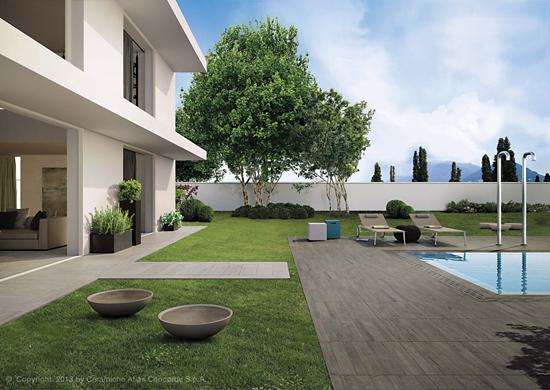Global Tile Show: Cersaie - November 2013
By Anne Harr
Cersaie is the undisputed global leader when it comes to ceramic tile expositions. Held annually in late September in Bologna, Italy, this trade fair attracts over 100,000 visitors from 157 different countries. This show’s continued success, even during difficult economic periods, can be attributed to a focus that extends beyond the product itself.
Granted, there is no other tile show in the world that achieves this scale—900 exhibitors from 32 countries in 21 huge exhibit halls. And there is no denying that no other show can offer the vast range of styling options available around the world, including the latest trends in thin tile, floating tile, digitally printed aesthetics and creative textures. But for many the real attraction is the exposure to some of the greatest architectural concepts in the conferences and seminars held over the course of this five-day show, in a cultural program themed “building, dwelling, thinking.”
One highlight from this year’s architectural focus was the release of a tribute film to Paulo Soleri who died earlier this year and who is probably best know for his focus on “Arcology,” combining architecture with ecology. Soleri is also the founder of Arcosanti, an experimental town 70 miles north of Phoenix where residents can live together in close proximity and without the need for cars. There was also a lecture by Rafael Moneo, a renowned Spanish architect who has designed buildings around the world and who was the chairman of Harvard Graduate School of Design in the mid 1980s. He is best known for the notion that urban buildings should “fit in” and not “show off.” And lastly, there was a panel of three successful women architects who spoke about the evolving role of women in architecture.
Product Trends
A tile trend that we have seen for some time now is the hardwood look. This year, we’re seeing several companies take that look beyond the traditional wood plank visual and extend it to a more sophisticated blend of texture, color and shape that gives the product more character. The old barn/vintage look, such as Settecento’s Vintage 97 or Italgraniti Group’s Scrapwood Collection, is increasingly popular along with tiles that look like parquet flooring or floors that you would find in an old villa or historical residence. Ceramica Sant’Agostino’s Royal Collection in an unusual 75cm x 75cm square format is a nice alternative to the usual plank styles, and it features dramatic grains, knots and veining in parquet patterns. Fossilized wood looks, like Cisa Ceramiche’s Jurassic Collection, offer consumers a more contemporary look with a touch of elegance and refinement.
While natural stone looks have been prevalent for quite some time, the continued evolution of digital inkjet technology has made it possible to create both more realistic looks and more creative and inventive designs than ever before. Manufacturers have mastered the art of digital reproduction. It would be virtually impossible to spot the difference between many of the exhibited marble, travertine, granite or other beautiful and realistic stone looks from the real thing.
Fiandre continues to wow with its ultra large, thin formats with new onyx, travertine and various marble looks added to its Marmi Maximum collection. This collection has no fiberglass reinforcement and is available in several large format sizes, the largest of which is 300cm x 150cm (5’x10’) which, according to Fiandre, can successfully be used for flooring. These ultra large tiles look like huge slabs of stone fresh from the quarry. Many stone collections have the appearance of years of aging and weathering. The Petra Collection from Emil offers a memorable reproduction of large slabs of limestone with a weathered texture of ancient, timeworn stone.
One of the hottest trends at the show was the modern minimalistic approach, represented by Imola’s Opificio Delle Pietre limestone design and Ceramiche Caesar’s Space Lipica stone-look collection. Atlas Concorde also had several new collections of stone looks. The Seastone Collection is a minimalistic contemporary take on natural stone slabs while the Marvel Collection offers the look of traditional Italian marble in either a matte or honed version.
In addition to natural looks of stone and wood, cement and oxidized metal looks were also in abundance. Atlas put it all together in its Mark Collection, which is an “all-in-one” collection containing looks derived from concrete, stone, marble, oxidized metal and wood. And Metalbax, a rusted metal look from Fioranese, was a stunner in its mirror, polished finish. Another great minimalistic collection we saw was Industrial from Floor Gres (a Florim brand). Industrial comes in several sizes ranging from 20cm x 80cm all the way to 1.2m x 3m in cool modern color options.
One of the notable features of porcelain is its ability to be used outdoors. Many manufacturers have included a 20mm thick large format tile collection to their lines. These tiles can be placed directly onto grass, sand or gravel. Most also offer a raised access type of installation system for areas that require drainage. Some of the manufacturers that we saw with the 20 mm thick outdoor tiles were Del Conca, Caesar, Atlas Concorde, Coem, Tagina, Florim, Refin and Nova Bell.
There were also some very decorative and highly graphic options at Cersaie. Tagina’s Deco Perlage celebrates the beauty of precious fabrics with grid and floral motifs. In a continuation of its collaboration with Studio FM Milano, Refin added to its successful Frame Collection by introducing Frame-UP, a creative new collection of graphic tiles. And Lea Ceramiche introduced Type-32, a project designed by Diego Grandi for the new 5mm thick SlimtechPlus line. Type-32 is a collection of four different patterns of wood look graphics that can be combined to create any number of patterns, limited only by your imagination.
Copyright 2013 Floor Focus
Related Topics: CERAMICS OF ITALY, Florim USA, CERSAIE
